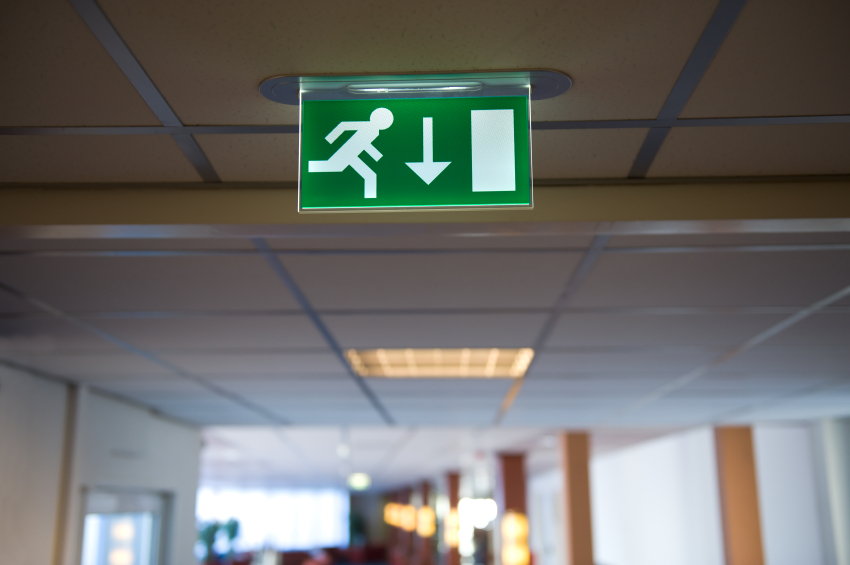Is Emergency Lighting a Legal Requirement?
If your building experiences a power failure for any reason, whether due to issues with the grid or damage caused by a fire, you could find yourself quite literally in the dark.
This creates a dangerous situation in many ways, not least because people will be unable to see properly, putting them in physical danger. The other risk that darkness presents is panic and anxiety, with people unsure of what to do or where to go.
Thankfully, this is where emergency lighting comes in, providing an automatic backup in an emergency situation that gives you enough illumination to evacuate a building calmly and safely. But is emergency lighting a legal requirement? That’s the question we’ll be answering this month at Surrey Tech Services Ltd.

Is emergency lighting a legal requirement?
Yes. That’s the simple answer. The long answer is that the Regulatory Reform (Fire Safety) Order 2005 dictates that all businesses must have emergency lighting in their premises for their escape and evacuation routes. Specifically, the order states under article 14 that:
“emergency routes and exits requiring illumination must be provided with emergency lighting of adequate intensity in the case of failure of their normal lighting.”
This means that in relation to emergency exits, they need to be indicated with lights that are illuminated even when there is a power failure.
In addition to this, there is also a British Standard for escape lighting to meet, which is BS EN 1838.
What are the different types of emergency lighting?
There are several different emergency lighting types that your premises may need depending on the type of business you have. These include:
- Escape route lighting – These are lights that illuminate your route out of a building. They highlight things such as emergency exits and fire escapes, ensuring people can safely use the nearest route.
- Open area emergency lighting – These are lights that are positioned in more open areas of a building to help avoid panic. When these kick in, people can then still see the immediate area around them before seeking out an emergency exit.
- High-risk task area lighting – These are lights for areas of working environments that involve dangerous machinery, substances or tools. In keeping these areas illuminated, workers can then safely stop their work and shut down any machinery before seeking an emergency exit.
- Standby lighting – This is not a legal requirement for a business, but is generally useful because you are able to carry on with work if there is a general loss of power.
What are the benefits of emergency lighting?
There are actually four major benefits of emergency lighting:
- It keeps people safe – This allows people to evacuate swiftly and safely to avoid danger
- Minimises panic – With clear lighting for escape routes, people can remain calm in an emergency
- It helps first responders – Any first responders attending an emergency can more easily navigate unfamiliar territory
- Legal compliance – As we’ve already outlined, it’s a legal requirement so it will ensure your business remains complaint
Where is emergency lighting required?
In any building, there might be numerous locations that require emergency lighting, with the government’s ‘Fire safety risk assessment: offices and shops’ document stating that it should be used for all of the following:
- each exit door
- escape routes
- intersections of corridors
- outside each final exit and on external escape routes
- emergency escape signs
- stairways so that each flight receives adequate light
- changes in floor level
- windowless rooms and toilet accommodation exceeding 8m2
- firefighting equipment
- fire alarm call points
- equipment that would need to be shut down in an emergency
- lifts
- areas in premises greater than 60m2
How often should emergency lighting be tested?
It’s always good to establish a routine for checking and testing your emergency lighting. For an official guideline of how often you should test them, the government recommendation is:
- a visual check of any controls each day
- a monthly test to check the controls work in illuminating the different emergency lamps
- and an annual test where the whole system is checked and left on for a full three-hour period.
Here at Surrey Tech Services Ltd, we’ll never leave you in the dark when it comes to emergency lighting. Not only can we install emergency lighting for your business, but we can also test it, too. You can even create a service contract with us to ensure you’re always up to date with your emergency lighting requirements to help keep your staff or residents safe.
As qualified, NICEIC-approved commercial electricians for London and the Home Counties – including Maidenhead, Guildford and Slough – you can count on our professional team to get the job done whether you run an office, a school or an HMO.
Call today to discuss your emergency lighting needs or to book a maintenance appointment.